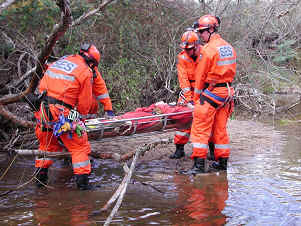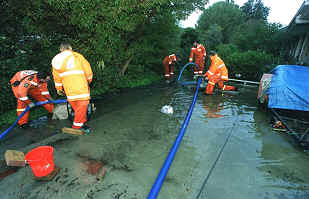South Australian floods
 |
| Click above map for searchable Google map of South Australia |
What to do in a flood emergency
Flood Information
A flood can be defined as water inundating land that is normally dry. That is fairly obvious, but you should never be complacent about floods as they can happen in a flash.
In the event of a flood:
- Never allow children to play in or near flood waters
- Never camp in a dry creek bed when bush-walking, creek trickles can turn into torrents very quickly
- Never drive in water of unknown depth or current
- Never eat food that has been in flood waters
What is a flood? Causes of flood Types of flood Before a flood Emergency Flood Plan Emergency Flood Kit During a Flood |  |
What is a flood?
A flood is water inundating land that is normally dry.Causes of flood
- Short, intense bursts of rain which overwhelm drainage systems.
- Flash floods often result when a storm moves slowly, so that a small area receives most of the rain. The drainage and runoff characteristics on the ground can also determine the area of greatest impact.
- Other causes of flash floods include dam failures or burst water mains.
Types of flood?
- Slow-onset floods - flooding of river systems in the northern pastoral areas of South Australia can spread for thousands of square kilometres and last for many weeks. This can cause damage to road and railways with potential for loss of stock and isolation of settlements and homesteads. Flooding of the River Murray can last for many days or weeks and impact towns and agricultural industries situated in the flood plain.
- Rapid on-set floods occur in steeper terrain such as the Mount Lofty Ranges and in rivers draining to the coast. These floods can be more damaging and pose a greater risk to life and property because there is less warning and much less time to take preventative and preparative action.
- Flash floods pose the greatest threat to loss of life and can result in substantial damage to property. Increased building density in urban areas is increasing the likelihood of flash flooding because drainage systems can no longer cope with the velocity and volume of water run-off.
How you can prevent flooding:
- Keep creeks clear of debris.
- Keep drains clear of debris.
- Sweep up fallen street tree leaves.
Before a Flood
To minimise your risks of flood damage before flooding occurs there are a few simple things you and your family can do to stay safe and protect your property. You should also prepare an Emergency Flood Plan and an Emergency Flood Kit in advance.- Ask your council about local flood plans (or records) which detail problem areas and evacuation routes and emergency relief centres. (To find out details about your local Council visit the Local Government Association website)
- Keep a list of emergency phone numbers on display.
- Advise neighbours of the impending flood and offer assistance when possible.
- Roll up rugs and move them to a higher level.
- Secure hazardous items.
- Monitor Bureau of Meteorology forecasts and warnings via their website or listen to your local emergency radio station or ABC Radio 891.
- Move electrical appliances to a higher level.
- Shift chemicals that may react with water to a higher level.
- Place important documents, personal effects and vital medical supplies in a waterproof case and move to a safe and easily accessible place in case you have to evacuate.
- Place furniture on beds and personal items on the furniture.
- Secure any item that may become buoyant in your yard (gas bottles, drums, timber etc.).
- Locate your pets and ensure they are safe.

During a Flood
During a flood you should take the following precautions:
- Secure your property and valuables.
- Turn off power sources such as gas and electricity and do not turn anything on again until you are sure it is safe to do so.
- Have waterproof bags ready to protect clothing and important documents.
- Never attempt to drive in flood waters. Be aware that roads can become treacherous and impassable due to heavy rains.
- Obey road closure signs and stick to the main roads.
- Always follow instructions and directions from local authorities and be ready to evacuate if necessary.
- Do not camp in creek beds.
- Never enter flood waters and in particular do not allow children to play in or near them.
- If stranded stay with your vehicle.
- Stay tuned to local radio for current weather advice and warnings.
If you stay, or on your return:

- Before entering your property make sure it is safe to do so.
- Wait until the water has dropped below floor level.
- Do not turn on any lights or appliances until a qualified electrician has checked the entire electrical system in your home including appliances.
- Stay tuned to local radio for updated advice.
- Don't allow children to play in, or near, flood waters.
- Avoid entering flood waters. If you must, wear solid shoes and check depth and current with a stick. Stay away from drains, culverts and water over knee-deep.
- Don't eat food which has been in flood waters.
- Boil tap water until supplies have been declared safe.
- When floodwater rises, it is common for spiders, snakes, rats and mice to look for a drier home - often inside our houses. If you have floodwater through your properly check for unwanted visitors.